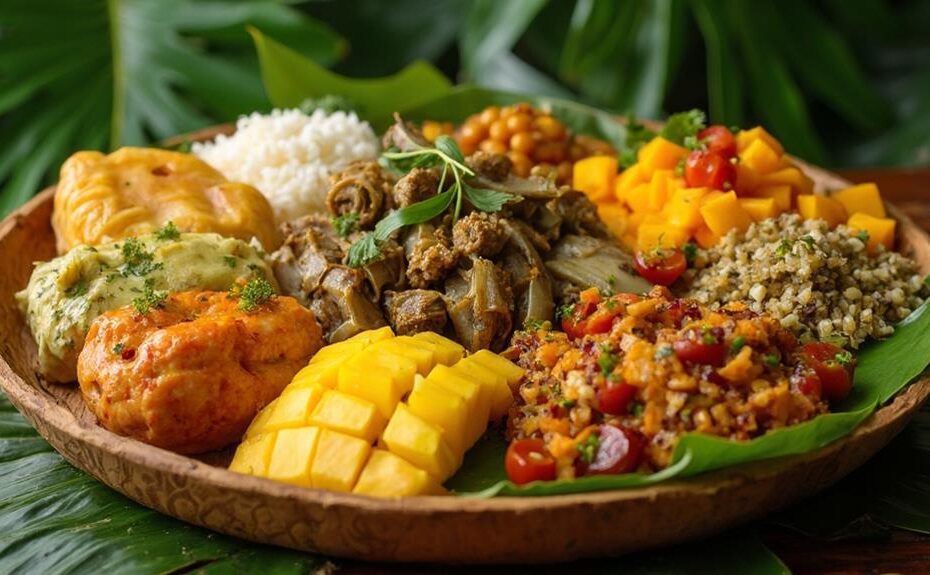Vegetarian and vegan Filipino food offers a rich culinary experience.
Traditional dishes like pinakbet and laing showcase the freshness of local vegetables. These vibrant dishes are a testament to the country's rich agricultural heritage.
Vegan alternatives to traditional Filipino dishes are also available. For example, jackfruit adobo and creamy kare-kare capture the authentic tastes of these classic dishes without the meat. These alternatives are made possible by the creative use of essential ingredients like coconut milk and calamansi, which infuse dishes with depth and flavor.
Mastering cooking techniques is key to enhancing flavors and nutrients. Sautéing and marinating are two essential techniques that bring out the best in plant-based ingredients. These techniques allow for the perfect balance of flavors and textures in dishes like vegan adobo and stir-fried vegetables.
Regional variations add unique flair to plant-based meals. Different regions in the Philippines offer their own twist on traditional dishes, making plant-based Filipino food a diverse and exciting culinary experience.
Overview of Filipino Cuisine
Filipino cuisine is a vibrant blend of flavors and influences that reflect the country's rich history and diverse culture.
The country's history has shaped the culinary landscape, where indigenous ingredients blend with Spanish, Chinese, and American flavors. This blend is evident in each dish, often featuring rice as a staple, accompanied by a variety of meats, vegetables, and bold spices.
The cultural heritage of Filipino folk music also resonates in the culinary traditions, where love and passion are poured into every dish.
Fresh herbs add layers of aroma and depth to Filipino dishes, with cilantro and lemongrass being popular choices. For example, adobo is a popular dish where meat is marinated in vinegar and soy sauce, creating a savory-sour sensation.
Sinigang, a tangy soup made with tamarind, brings warmth and comfort, while lechon showcases a whole roasted pig, celebrated for its crispy skin and succulent meat.
Street food plays a significant role in Filipino culture, with treats like lumpia (spring rolls) and fish balls offering quick and delicious bites.
The communal aspect of dining is central, as meals are often shared among family and friends, embodying the spirit of hospitality that defines Filipino culture. Each bite connects you to the archipelago's heart and soul, making every meal a memorable experience.
Popular Vegetarian Dishes
Filipino Vegetarian Delights
Filipino cuisine offers a variety of delicious vegetarian dishes that showcase the country's rich flavors.
Pinakbet is a standout dish, a savory vegetable stew made with a mix of fresh vegetables like eggplant, squash, and bitter melon, all cooked in a flavorful shrimp paste or a plant-based alternative.
Another beloved option is Laing, which features dried taro leaves simmered in coconut milk, providing a creamy, aromatic dish that's both hearty and satisfying.
Gising-Gising is a spicy dish made with green beans and ground peanuts, offering a delightful crunch and a kick of heat.
These dishes celebrate the essence of Filipino cooking and make it easy for you to enjoy a fulfilling meal without meat.
Vegetarian Options:
- Pinakbet: A hearty vegetable stew with rich flavors.
- Laing: Creamy taro leaves in coconut milk, full of aromatic goodness.
- Gising-Gising: A spicy, crunchy mix that's sure to awaken your taste buds.
These Filipino vegetarian dishes are a testament to the country's vibrant culinary identity.
Innovative Vegan Alternatives
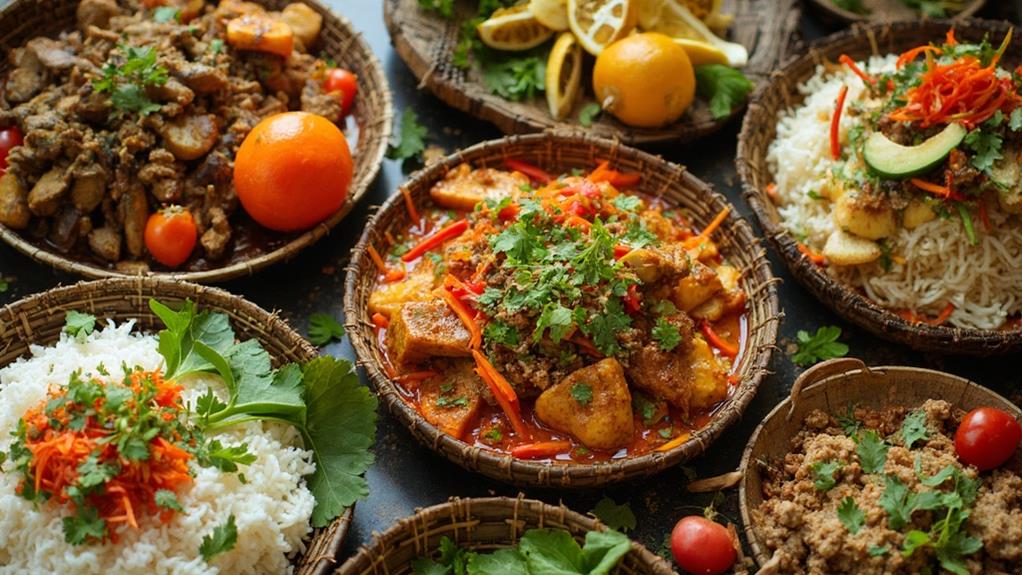
Vegan Filipino cuisine is transforming traditional dishes into plant-based delights.
Innovative vegan alternatives are reimagining classic Filipino flavors with plant-based ingredients. A rich, creamy vegan adobo made with jackfruit, soy sauce, vinegar, and spices captures the essence of the traditional dish. This dish proves that you don't need meat to enjoy the classic flavors.
Filipino designers blend modern style with indigenous patterns, and a similar approach is seen in vegan Filipino food. Traditional flavors are reimagined with plant-based ingredients, creating a new wave of dishes. Kare-kare, typically made with oxtail, is now reimagined with eggplant, green beans, and a luscious peanut sauce. This vegan version is just as satisfying as the original.
Vegan lumpia is filled with a vibrant mix of vegetables and tofu, wrapped in a delicate rice paper shell. This dish is perfect for dipping in sweet chili sauce.
For a sweet treat, vegan halo-halo features shaved ice topped with coconut milk, sweetened fruits, and a scoop of ube ice cream made from plant-based ingredients.
These innovative dishes not only honor Filipino culinary traditions but also promote a healthier lifestyle. Plant-based versions can be equally flavorful and fulfilling. With each new creation, you'll discover that Filipino flavors can be celebrated in a whole new way, whether you're a lifelong vegan or just curious.
Key Ingredients for Plant-Based Cooking
Key Ingredients for Plant-Based Filipino Cooking
To craft authentic plant-based Filipino dishes, you need to stock your kitchen with essential ingredients that capture the essence of traditional flavors.
These staples enhance the taste of your meals and provide the foundation for authentic Filipino cuisine.
Coconut Milk: This creamy ingredient is a must-have for your pantry.
It adds richness to soups, curries, and desserts, and its subtle sweetness complements the spices and herbs typical in Filipino dishes.
Soy Sauce: A staple in many Filipino recipes, soy sauce brings depth and umami to your cooking.
Use it to marinate vegetables or add a savory kick to stir-fries.
Calamansi: This small citrus fruit is a flavor powerhouse.
It lends a unique tartness to your dishes, and you can use it in dressings, dips, or as a finishing touch to elevate the taste of your meals.
Traditional Dishes Reimagined
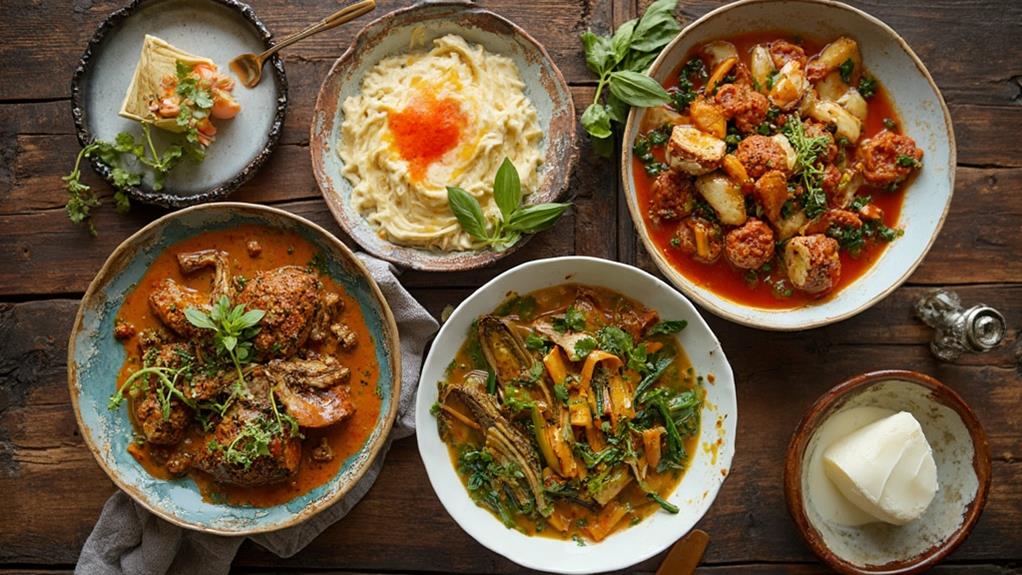
Reimagining traditional Filipino dishes with plant-based ingredients honors cultural heritage while embracing a healthier lifestyle.
Transforming classic Filipino meals like adobo is a great way to start. Replace meat with tofu or tempeh, and simmer it in a rich marinade of soy sauce, vinegar, and garlic. This combination of flavors creates a dish that's both nostalgic and nourishing.
Another beloved dish, sinigang, can easily be made vegan. Incorporate a variety of vegetables like radish, eggplant, and green beans, and use tamarind or a mix of citrus for that signature sour kick. This flavorful and comforting dish is sure to become a favorite.
Lumpia, the Filipino spring roll, can also be reimagined with plant-based fillings. Swap out traditional meat fillings for a medley of vegetables or even jackfruit for a heartier texture. Wrapped in a crispy shell, these tasty bites make for an irresistible appetizer.
For dessert, create a vegan version of leche flan by blending silken tofu with coconut milk and a touch of sweetener. This creamy and sweet treat is a perfect way to end a meal.
Cooking Techniques for Plant-Based Meals
Mastering key cooking techniques is essential for preparing delicious plant-based meals. These techniques enhance flavors, transform ingredients, and make cooking an enjoyable process.
Sautéing is a fundamental technique that brings out the natural flavors of vegetables. To sauté effectively, use high-quality oils like coconut or olive oil to add depth and richness to your dishes.
Steaming is a healthy cooking method that preserves nutrients in vegetables. This technique helps maintain their vibrant colors and crisp textures. To steam like a pro, use a bamboo steamer, which is an eco-friendly and sustainable option.
Marinating is a crucial step in preparing plant-based proteins like tofu or tempeh.
Marinating infuses flavor into these proteins, making them more delicious and savory. To create a tasty marinade, combine soy sauce, vinegar, and spices to create a flavorful blend.
How can Filipino Ingredients be Incorporated into Vegetarian and Vegan Filipino Food?
Filipino ingredients offer a rich array of flavors and textures that can easily be incorporated into vegetarian and vegan Filipino dishes. By utilizing the nutritional benefits of filipino ingredients such as adobo tofu with soy sauce, calamansi, coconut milk, and kesong puti, a variety of delicious and healthy options can be created.
Regional Variations in Vegetarian Options
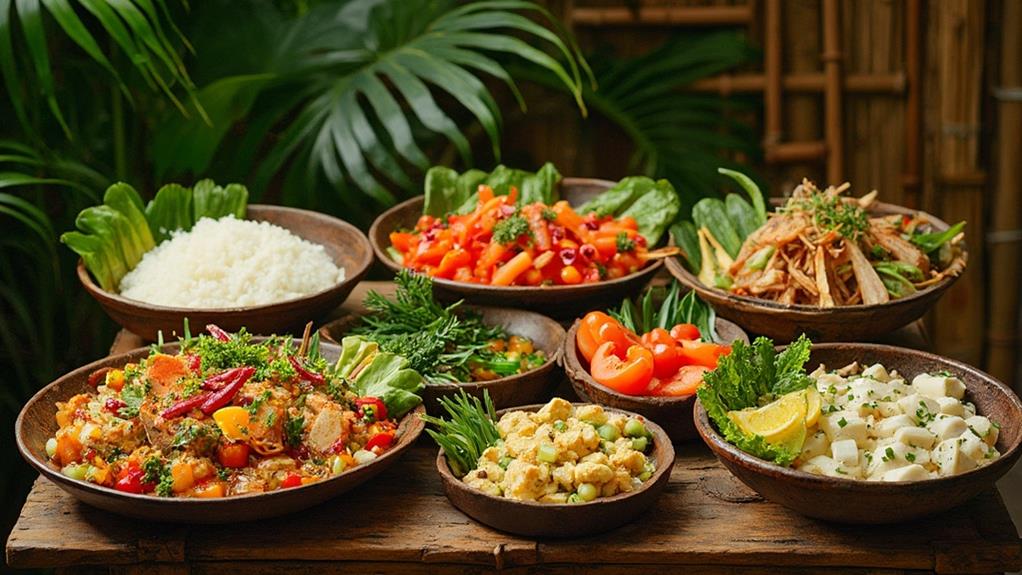
Filipino cuisine offers diverse vegetarian options that vary by region. In the northern regions, like Luzon, pinakbet is a popular vegetable stew made with local produce like bitter melon and eggplant, typically seasoned with shrimp paste, which can be easily substituted with a plant-based alternative.
The Visayas region is known for its creative twists on traditional dishes. Kinilaw, usually made with raw fish, can be reinvented using ripe mango or tofu marinated in vinegar and spices for a refreshing vegetarian version.
Mindanao's cuisine is characterized by the use of coconut milk. In dishes like ginataang sitaw, long green beans are simmered in creamy coconut sauce, offering a rich and flavorful vegetarian option.
Traditional Filipino dishes can be easily adapted to fit a vegetarian lifestyle. For example, adobo can be made with soy curls or jackfruit as a meat substitute, allowing vegetarians to experience the essence of Filipino culture.
Each region offers unique ingredients and techniques, allowing vegetarians to customize traditional meals while still savoring the heart of the Philippines in every bite.
Nutritional Benefits of Plant-Based Diets
Plant-based diets offer numerous nutritional benefits that support overall health and well-being.
High in Fiber: Plant-based foods are rich in fiber, which aids digestion, promotes gut health, and keeps you feeling full longer.
For example, a single serving of brown rice, a staple in Filipino cuisine, provides about 3.5 grams of fiber.
Lower in Saturated Fats: Many plant-based dishes are naturally lower in saturated fats, which can reduce the risk of heart disease and improve overall cardiovascular health.
Vegetarian options like grilled eggplant and tomatoes, commonly used in Filipino dishes, are low in saturated fats and high in nutrients.
Rich in Vitamins and Antioxidants: Fruits and vegetables are packed with vitamins and antioxidants that help boost the immune system and protect the body from oxidative stress.
For instance, a serving of mango, a popular fruit in the Philippines, provides about 45% of the daily recommended intake of vitamin C, a powerful antioxidant.
Resources for Plant-Based Filipino Recipes
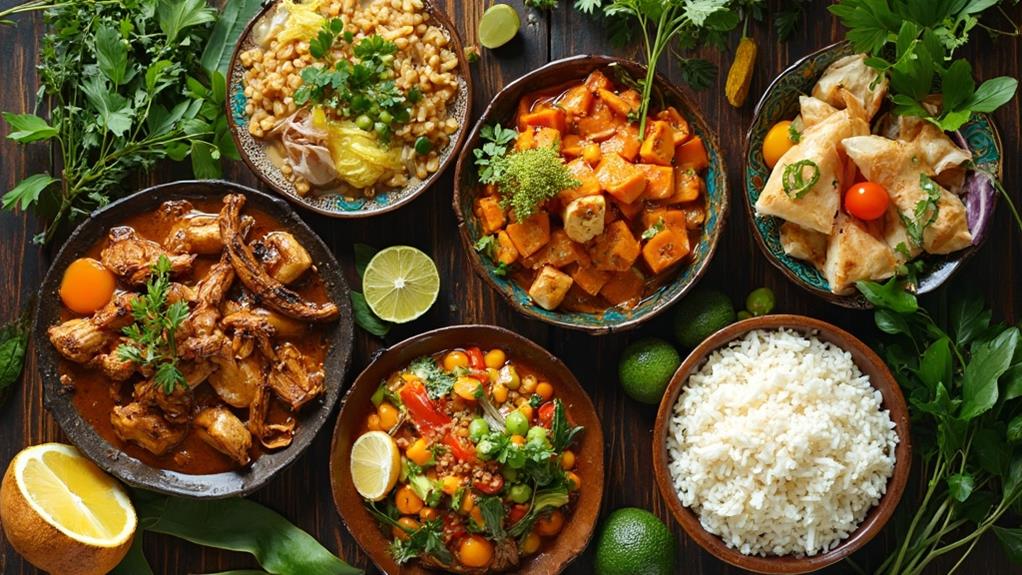
Explore Plant-Based Filipino Recipes with These Resources
Cookbooks
"The Filipino Vegan" by Aileen Suzara offers authentic plant-based recipes, perfect for beginners and experienced chefs alike.
Online Platforms
Pinterest and Instagram are treasure troves of plant-based Filipino recipes, featuring stunning visuals and innovative twists on classic dishes.
Cultural Inspiration
The rich cultural heritage of Philippine textiles, such as the traditional T'nalak fabric, can inspire creative plant-based recipes.
Blogs
"The Hungry Caterpillar" and "Vegan Filipino Food" provide step-by-step guides and personal stories behind each recipe, making it easy to follow along.
YouTube Channels
Dedicated Filipino cuisine YouTube channels often feature vegan adaptations, allowing for easy visual follow-along.
Online Communities
Join online forums and communities where fellow plant-based enthusiasts share their favorite recipes and tips, providing a wealth of knowledge and support.
